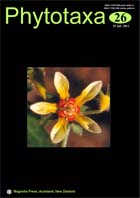Abstract
The species allied to Cyathea platylepis are recognized as a distinct group among Neotropical Cyathea, and are regarded as closest relatives to the few Paleotropical members of the genus in the strict sense. All species have slender trunks that shed old petioles cleanly, inermous petioles with relatively few, ovate-lanceolate brown scales, relatively strongly dissected (to tripinnate-pinnatifid) laminae, and proximally positioned sori with hemitelioid indusia. Most of the remaining Neotropical species referred to as the C. multiflora-group fall into two distinct groups. The group of Cyathea vilhelmii differs from the C. platylepis group chiefly in having dense petiolar scurf, and bicolorous or concolorous white petiole scales. These species occur at high elevations in the Andes and Central America. The group of Cyathea multiflora is heterogeneous in habit and laminar dissection but is characterized by a medial to marginal position of the sori and a preference of lower montane and lowland forests. It includes the species allied to C. multiflora and C. andina, as well as some species formerly regarded as belonging to Sphaeropteris. All groups may have to include species that either have different types of indusia or lack them in order to represent natural taxa. Five names have been reinstated in the course of this study and replace commonly used names: Cyathea austroamericana (= C. multiflora pro parte), C. boryana (= C. andina pro parte), C. leucolepismata (= C. amazonica), C. lindigii (= C. multiflora pro parte), C. traillii (= C. reginae), and C. vilhelmii (= C. heliophila). Cyathea vaupensis is recognized at species level. A new name is chosen for Cyathea panamensis = Cyathea rojasiana. Keys to all species are included.

